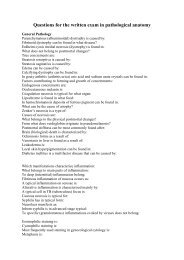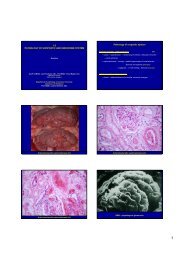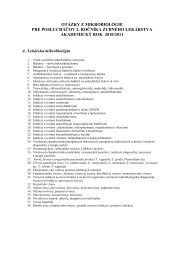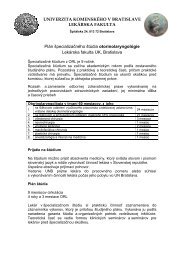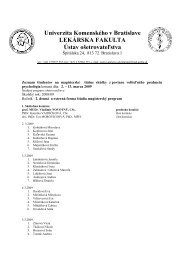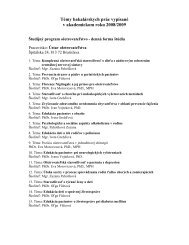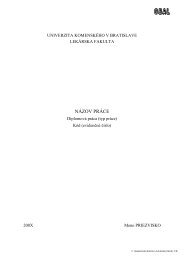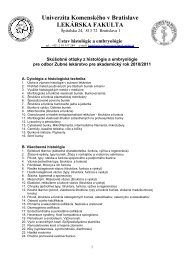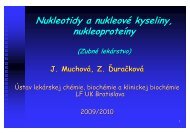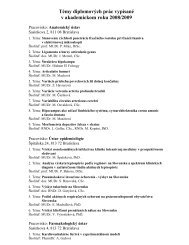VITAMINS and COENZYMES
VITAMINS and COENZYMES
VITAMINS and COENZYMES
You also want an ePaper? Increase the reach of your titles
YUMPU automatically turns print PDFs into web optimized ePapers that Google loves.
<strong>VITAMINS</strong> <strong>and</strong> <strong>COENZYMES</strong><br />
INGRID ŽITŇANOVÁ<br />
2010/2011
Introduction to Vitamins<br />
VITAL + AMINES = VITAMIN<br />
Organic molecules, essential for the normal<br />
growth <strong>and</strong> development, required in tiny amounts<br />
Cannot be synthesized by mammalian cells<br />
must be supplied in the diet<br />
Vitamin C – human<br />
Vitamin A - from precursor<br />
Vitamin K, H – gut flora<br />
Vitamin D – skin (UV light)
FUNCTIONS<br />
• Regulate metabolism, help convert lipids <strong>and</strong> saccharides<br />
into energy<br />
• Hormones (vitamin D)<br />
• Antioxidants (vitamin E)<br />
• Regulators of cell <strong>and</strong> tissue growth <strong>and</strong> differentiation<br />
(vitamin A)<br />
• Precursors for enzyme coenzymes (B-complex)
AVITAMINOSIS - chronic or long-term vitamin deficiency<br />
(beri-beri, scurvy, rickets <strong>and</strong> pellagra)<br />
HYPOVITAMINOSIS - any of several diseases caused by<br />
deficiency of one or more vitamins<br />
HYPERVITAMINOSIS – the condition resulting from the<br />
chronic excessive intake of vitamins (vitamin supplements)<br />
side effects – nausea, diarrhea, vomiting<br />
ANTI<strong>VITAMINS</strong> – a substance that destroys or inhibits<br />
the metabolic action of a vitamin.
Avitaminoses<br />
Vitamin A deficiency causes xerophthalmia or night blindness<br />
Thiamine (B 1 ) deficiency causes beri-beri<br />
Niacin (B 3 ) deficiency causes pellagra<br />
Vitamin B 12 deficiency leads to megaloblastic anemia<br />
Vitamin C deficiency leads to scurvy<br />
Vitamin D deficiency causes rickets<br />
Vitamin K deficiency causes impaired coagulation<br />
• Rare in developed world - fortification
ANTI<strong>VITAMINS</strong><br />
Antivitamins - chemotherapy of several infectious diseases<br />
Classification:<br />
1. Enzymes decomposing vitamins (tiaminase, ascorbase)<br />
2. Compounds forming nonactive complexes with vitamins (avidin)<br />
3. Compounds structurally similar to vitamins (sulphonamides)<br />
H 2 N<br />
C OH<br />
O<br />
H 2 N<br />
S NH 2<br />
Paraaminobenzoic acid (PABA) Sulphonamide O<br />
Sulphonamides – prevent bacterial multiplication, without toxicity to the human tissues<br />
O
GTP<br />
PABA<br />
Sulphon<br />
onamide<br />
– prevents growth <strong>and</strong> division of MO<br />
interfering with PABA action<br />
FOLIC ACID COENZYME (THF) Purin <strong>and</strong><br />
pyrimidin<br />
synthesis<br />
PABA – growth factor for MO<br />
H 2<br />
N<br />
SO 2<br />
H 2<br />
N<br />
COOH<br />
sulphonamide<br />
p-aminobenzoic<br />
acid (PABA)
Water Soluble Vitamins<br />
Fat Soluble Vitamins<br />
Thiamine (B1)<br />
Riboflavin (B2)<br />
Niacin (B3)<br />
Panthotenic acid (B5)<br />
Pyridoxin (B6)<br />
Biotin (B7 ) – vitamin H<br />
Folic acid (B9)<br />
Cobalamin (B12)<br />
Bioflavonoids (P)<br />
Ascorbic acid (vit. C)<br />
Vitamin A - Retinol<br />
Vitamin D - Calciferol<br />
Vitamin E - Tocoferol<br />
Vitamin K – Quinons<br />
Vitamin F
Vitamins soluble in water<br />
directly absorbed from intestine into blood<br />
hypervitaminosis – vitamins excreted from the body<br />
Vitamins soluble in fat<br />
require correct function of the liver <strong>and</strong> gall bladder<br />
hypervitaminosis – toxic effect
VITAMIN A = R E T I N O L<br />
Its provitamin - β-carotene - (red, orange pigments in plants <strong>and</strong> fruits)<br />
- Antioxidant<br />
Structure: tetraterpenoid containing β-ionone ring with an unsaturated<br />
side chain<br />
α-, β- a γ- provitamin A
15<br />
2<br />
O 2<br />
15'<br />
β-carotene<br />
β-karotén<br />
Fe 2+ dioxygenáza dioxygenase<br />
1<br />
all-trans retinal izomeráza isomerase<br />
kyselina Retinoicretinová<br />
acid<br />
dehydrogenáza<br />
dehydrogenase<br />
11<br />
11<br />
CH 2 OH<br />
1<br />
1<br />
trans retinol 1 - vitamín A 1<br />
11-cis retinal CHO<br />
Premeny β-karoténu a vitamínu A 1<br />
CHO COOH
All-trans-retinal<br />
11-cis-retinal<br />
Retinol<br />
Kyselina retinová<br />
Retinoic acid
Functions of vitamin A<br />
• Vision – retinal is a structural part of rhodopsin (visual purple) –<br />
light sensitive pigment in retina<br />
• Bone remodeling – function of osteoblasts <strong>and</strong> osteoclasts depend<br />
on it. Excess – bone loss, hip fracture (increase of osteoclasts – cells,<br />
that break down bones)<br />
• Reproduction – sperm production, menstrual period<br />
• Resistance to infectious disease – deficiency leads to increased<br />
frequency <strong>and</strong> severity of disease<br />
• Epithelial cell "integrity“ – they require vitamin A for proper<br />
differentiation <strong>and</strong> maintenance. Lack of vitamin A - the skin becomes<br />
keratinized <strong>and</strong> scaly, <strong>and</strong> mucus secretion is suppressed.
R<br />
E<br />
VISION CYCLE<br />
RHODOPSIN<br />
(PIGMENT)<br />
LIGHT<br />
T<br />
I<br />
N<br />
CIS-RETINAL<br />
OPSIN<br />
TRANS-RETINAL-OPSIN<br />
NERVE<br />
IMPULS<br />
A<br />
RETINAL<br />
ISOMERASE<br />
TRANS-RETINAL<br />
DEHYDROGENASE<br />
NADH+H +<br />
NAD +<br />
TRANS -RETINOL<br />
Retinolesters (liver)<br />
transport by blood proteins
HYPOVITAMINOSIS A<br />
Night blindness – mild deficiency of vitamin A – inability to<br />
produce sufficient amount of rhodopsin (lack of retinal)<br />
Large deficiency of vit. A – xeroftalmia – keratinisation of the eye<br />
tissue (today in Africa, Asia)<br />
Dry skin, frequent infections, decreased synthesis of thyroid<br />
hormones
HYPERVITAMINOSIS<br />
β-carotene supplements (high doses)<br />
• Lung cancer / smokers /<br />
• Skin discoloration<br />
Retinal<br />
• Birth defects<br />
• Liver problems<br />
• Reduced bone mineral density that may result in<br />
osteoporosis<br />
• Coarse bone growths<br />
• Hair loss<br />
• Excessive skin dryness/peeling<br />
• Death<br />
Signs of acute toxicity – nausea, vomiting, headache, dizziness, blurred<br />
vision, loss of muscular coordination
SOURCES<br />
β-carotene - carrot, green leafy vegetables – spinach, kale,<br />
sweet potatoes, yellow <strong>and</strong> orange fruits<br />
Retinal – liver of polar bear, seal, eggs <strong>and</strong> fatty fish
<strong>VITAMINS</strong> D - CALCIFEROL<br />
• Increases Ca into bloodstream by promoting absorption of<br />
Calcium <strong>and</strong> Phosphorus from food in the intestines <strong>and</strong><br />
reabsorption of Ca in the kidneys, enabling normal mineralization<br />
of bone<br />
2 types:<br />
D 2 – derived from precursor ergosterol present in plants<br />
D 3 – derived from precursor 7-dehydrocholesterol<br />
present in skin<br />
Structure similar to steroid hormones (cortizol, estradiol, progesteron) - derived<br />
from cholesterol
UV<br />
7-dehydrocholesterol (skin) cholecalciferol<br />
(provitamin) (D3, calciol)<br />
UV<br />
Ergosterol (plants) ergocalciferol (D2, ercalciol)<br />
(provitamin)<br />
Adequate amounts of vitamin D 3 can be made in the skin after only<br />
10 -15 minutes of sun exposure at least 2x per week to the face,<br />
arms, h<strong>and</strong>s, or back without sunscreen
7-dehydrocholesterol Cholekalciferol (D 3 )<br />
Plants<br />
Ergosterol pre-D 2
UV<br />
Kidneys: 25-hydroxylase<br />
Liver: 1-hydroxylase
SKIN<br />
7-dehydrocholesterol<br />
Increased parathyroid hormone
DEFICIENCY<br />
Results from a number of factors:<br />
<br />
inadequate intake coupled with inadequate sunlight<br />
exposure<br />
<br />
liver or kidney disorders (impair conversion of vitamin<br />
D into active metabolites)<br />
<br />
body characteristics (skin color <strong>and</strong> body fat)
DEFICIENCY<br />
Leads to impaired bone mineralization, <strong>and</strong> to bone softening diseases including:<br />
• RICKETS - a childhood disease - impeded growth, <strong>and</strong><br />
deformity of the long bones<br />
• OSTEOMALACIA - a bone-thinning disorder<br />
occurs exclusively in adults proximal muscle<br />
• OSTEOPOROSIS - reduced bone mineral density <strong>and</strong><br />
increased bone fragility
Stunted growth<br />
Large<br />
forehead<br />
Odd curve to spine or<br />
back<br />
Odd-shaped<br />
ribs <strong>and</strong><br />
breast bones<br />
Large<br />
abdomen<br />
Wide joints at<br />
elbow <strong>and</strong><br />
wrist<br />
Wide<br />
bones<br />
Odd-shaped<br />
legs<br />
Wide ankles
Vitamin D malnutrition may also be linked to an<br />
increased susceptibility to several chronic diseases:<br />
<br />
<br />
<br />
<br />
<br />
<br />
<br />
<br />
high blood pressure<br />
tuberculosis<br />
cancer<br />
periodontal disease<br />
multiple sclerosis<br />
chronic pain<br />
memory loss<br />
autoimmune diseases including type 1 diabetes
Sources of vitamin D<br />
Fatty<br />
<br />
<br />
<br />
<br />
Fish liver oils<br />
Fatty fish species<br />
A whole egg<br />
Beef liver, cooked<br />
UV-irradiated mushrooms (Vitamin D 2 )
Vitamin E – Tocopherols<br />
antisterile vitamin<br />
•<br />
Benefits<br />
• Protects lipids (cell membranes), DNA, proteins from<br />
oxidation – ANTIOXIDANT<br />
Protects food fats from going rancid<br />
• Helps to form red blood cells<br />
• Aids in the absorption of vitamin K
Vitamin E protects cell membrane lipids from oxidation by reacting<br />
with lipid radicals produced in the lipid peroxidation chain reaction<br />
Free radical<br />
Cell<br />
Mitochondria
R<br />
vitamín E<br />
vitamín E<br />
RH<br />
O=C<br />
O-C<br />
HO-C<br />
vitamín E + vitamín C vitamín E + H-C<br />
HO-C-H<br />
O<br />
CH 2 OH<br />
Radical of<br />
radikál<br />
L-ascorbic<br />
acid radical<br />
L-ascorbic kyseliny acid<br />
L-<br />
askorbovej<br />
O=C O=C O=C O=C<br />
O-C<br />
O<br />
O-C<br />
O<br />
HO-C<br />
O<br />
O=C<br />
HO-C HO-C HO-C O=C<br />
+ +<br />
H-C H-C H-C H-C<br />
O<br />
HO-C-H HO-C-H HO-C-H HO-C-H<br />
CH 2 OH<br />
Radical of<br />
radikál<br />
kyseliny L-ascorbic<br />
acid L-<br />
acid radical<br />
CH 2 OH<br />
Radical of<br />
radikál<br />
kyseliny<br />
L-ascorbic<br />
L-ascorbic<br />
L- acid radical<br />
acid<br />
askorbovej<br />
Nonenzymatic scavenging<br />
of free radicals by vitamins<br />
Nonenzyme scavenging of free radicals by vitamins<br />
Neenzýmové vychytávanie radikálov vitamínmi<br />
CH 2 -OH CH 2 -OH<br />
ascorbate<br />
Ascorbic askorbát acid<br />
dehydroascorbate<br />
Dehydroascorbic acid<br />
GS-SG 2 GSH<br />
dehydroaskorbá<br />
Glutathione glutatiónreduktáza<br />
t<br />
reductase<br />
NADPH<br />
pentózafosfátový<br />
Pentose<br />
NADP +<br />
Phosphate<br />
cyklus<br />
cycle
STRUCTURE: tocol, forms 8 basic derivatives<br />
α-tocopherol is a most effective form<br />
R 2<br />
R 3<br />
O<br />
CH 3 CH 3 CH 3<br />
HO<br />
R 1 R 2 R 3<br />
Tocol α -CH 3<br />
-CH 3<br />
-CH 3<br />
CH 3<br />
R 1<br />
Chromanol ring<br />
HO- group - reduction of free radicals<br />
Saturated side chain – penetration in membranes<br />
β -CH 3 -H -CH 3<br />
γ -H -CH 3<br />
-CH 3<br />
δ -H -H -CH 3<br />
R3<br />
R2<br />
O<br />
CH 3<br />
CH 3 CH 3 CH 3<br />
CH 3<br />
HO<br />
tocotrienol<br />
R1
Deficiency<br />
neurological problems, anemia<br />
Natural Sources<br />
green leafy vegetable, vegetable oils, nuts, seeds, spinach,<br />
broccoli, soybean oil
VITAMIN K - QUINONES<br />
Vitamin K1 (phylloquinone) - from plants sources<br />
Vitamin K2 (menaquinone) - made by intestinal bacteria<br />
(production can be disturbed by antibiotics, Crohn disease, gallstones)<br />
Vitamin K3 (menadione, menadiol) - synthetic<br />
German „koagulation“<br />
vitamin K
Overview<br />
• Promotes normal blood clotting (coagulation)<br />
• Bone metabolism<br />
• Vascular health<br />
Biochemistry<br />
coenzyme for a vitamin K-dependent carboxylase –<br />
carboxylation of glutamic acid gammacarboxyglutamic<br />
acid (Gla)– involved in binding Ca 2+<br />
Vitamin K<br />
clotting factor-glutamic acid clot.factor-Gla-Ca 2+<br />
carboxylase<br />
nonactive<br />
CO 2<br />
active
Bone metabolism<br />
• gamma-carboxylation of osteocalcin (bone-related<br />
protein) in the presence of vitamin K<br />
Vascular health<br />
• decreases calcification in the arteries by absorbing the<br />
hardened calcium to lessen risk of heart disease
Deficiency<br />
Rare in healthy adults: 1) vitamin K widespread in foods<br />
2) vitamin K cycle conserves vitamin K<br />
3) large intestine bacteria synthesize vit. K<br />
Adults at risk:<br />
• those taking vitamin K antagonist - anticoagulant drugs<br />
• adults with significant liver damage<br />
• newborn babies – exclusively breast-fed:<br />
1) vitamin K is not easily transported across the placental<br />
barrier<br />
2) the newborn's intestines are not yet colonized with bacteria<br />
that synthesize menaquinones<br />
3) the vitamin K cycle may not be fully functional in newborns
Isoprene units<br />
(K2)
Toxicity<br />
Vitamin K 1 , K 2 – no known toxicity<br />
Vitamin K 3 – interferes with glutathione (antioxidant)<br />
oxidative damage to cell membranes.<br />
- injections – liver toxicity, jaundice, hemolytic<br />
anemia in infants
Warfarin<br />
Bromadiolon<br />
(anticoagulant)<br />
(Anticoagulant)
Natural Sources<br />
green leafy vegetables – alpha-alpha, Brussel sprouts,<br />
spinach, kale, cabbage, avocado, cheddar cheese
VITAMIN F<br />
ESSENTIAL UNSATURATED HIGHER<br />
CARBOXYLIC ACIDS<br />
Structure: unsaturated higher carboxylic acids<br />
• Linoleic acid - 2 double bonds 18:2<br />
• Linolenic acid - 3 double bonds 18:3<br />
• Arachidonic acid??? – 4 double bonds 20:4– synthesized<br />
from linoleic acid in the body<br />
Fatty acids needed for:<br />
normal growth, behavior, healthy cell membranes, well balanced<br />
hormone level, immune system
Linoleic acid<br />
ω-6 fatty acid<br />
Arachidonic<br />
acid<br />
ω-6 fatty acid<br />
Linolenic acid<br />
ω-3 fatty acid
ARACHIDONIC ACID WITH 4 DOUBLE BONDS<br />
cyclooxygenase<br />
lipoxygenase<br />
epoxides<br />
prostagl<strong>and</strong>ins<br />
leukotriens<br />
prostacyclins<br />
tromboxanes<br />
cytochrom P 450<br />
The eicosanoids from AA generally promote inflammation
VITAMIN B 1 – THIAMINE, ANEURINE<br />
(antineuritic factor, antiberiberi factor)<br />
PYRIMIDINE <strong>and</strong> THIAZOL rings linked through<br />
methylene bridge<br />
Antagonists – Sulfites (food preservatives) – attack at the<br />
methylene bridge
VITAMIN B 1 – THIAMINE, ANEURIN<br />
Natural thiamine phosphate derivatives:<br />
thiamine monophosphate (TMP)<br />
thiamine diphosphate (TDP) (pyrophosphate TPP)<br />
thiamine triphosphate (TTP)<br />
Phosphate derivatives involved in many cellular<br />
processes<br />
COENZYME = thiamine diphosphate – cocarboxylase -<br />
in catabolism of saccharides <strong>and</strong> aminoacids
Thiamine pyrophosphate<br />
TPP - cofactor for the pyruvate dehydrogenase<br />
- alpha-ketoglutarate dehydrogenase catalyzed reactions<br />
- the transketolase catalyzed reactions of the pentose<br />
phosphate pathway.
TPP<br />
TPP
Deficiency<br />
severely reduced capacity of cells to generate energy<br />
BERI-BERI - affecting the peripheral nervous system<br />
(polyneuritis) <strong>and</strong>/or the cardiovascular system, with<br />
fatal outcome<br />
Overdose<br />
Hypersensitive reactions resembling anaphylactic shock<br />
Natural Sources<br />
Meat, potatoes, bananas, lentils, beans, yeast<br />
Interactions<br />
Antibiotics - Decrease thiamine level
Overview<br />
Essential to energy generation<br />
Riboflavin - precursor for the coenzymes FAD, FMN – redox<br />
reactions<br />
FLAVIN MONONUCLEOTIDE (FMN)<br />
FLAVIN ADENINE DINUCLEOTIDE (FAD)<br />
The enzymes requiring FMN or FAD as cofactors – flavoproteins<br />
– involved in redox reactions (succinate dehydrogenase <strong>and</strong><br />
xanthine oxidase)
VITAMIN B 2 – RIBOFLAVIN<br />
Lactoflavin, ovoflavin, vitamin G<br />
ribitol<br />
Riboflavin powder.<br />
Riboflavin solution<br />
METHYL DERIVATE OF IZOALOXAZINE + RIBITOL
FUNCTION:<br />
• Key role in energy metabolism - required for the metabolism of<br />
lipids, saccharides, <strong>and</strong> proteins<br />
• It is the central component of the cofactors FAD (flavinadenin<br />
dinucleotide) <strong>and</strong> FMN (flavinmononucleotide)
Riboflavin<br />
Flavinmononucleotide<br />
(FMN)<br />
Flavinadenine dinucleotide<br />
reduc.<br />
(FADH 2 )
FAD<br />
Nitrogens 1 & 5 transfer hydrogen in FADH 2<br />
Riboflavin<br />
H<br />
H
Deficiency<br />
Fatigue, red, swollen, cracked mouth <strong>and</strong> tongue, mouth<br />
ulcers, cracks at the corners of the mouth<br />
Riboflavin deficiency is often seen in chronic<br />
alcoholics due to their poor dietetic habits<br />
Overdose<br />
Itching, numbness, a burning sensation<br />
Storage<br />
Riboflavin decomposes when exposed to visible light<br />
This characteristic can lead to riboflavin deficiencies in<br />
newborns treated for hyperbilirubinemia by phototherapy
Food sources<br />
Food<br />
Serving<br />
Riboflavin<br />
(mg)<br />
Fortified cereal 1 cup 0.59 to 2.27<br />
Milk (nonfat) 1 cup (8 ounces) 0.34<br />
Egg (cooked) 1 large 0.27<br />
Almonds 1 ounce 0.23<br />
Spinach (boiled) 1/2 cup 0.21<br />
Salmon (cooked) 3 ounces* 0.12<br />
Cheddar cheese 1 ounce 0.11<br />
Chicken, dark meat<br />
(roasted)<br />
3 ounces 0.16<br />
Beef (cooked) 3 ounces 0.16<br />
Broccoli (boiled) 1/2 cup chopped 0.10<br />
Asparagus (boiled) 6 spears 0.13<br />
Halibut (broiled) 3 ounces 0.08
Vitamin B-3, Niacin, vitamin PP<br />
Nicotinic Acid<br />
Nicotinamide<br />
nicotinic acid + vitamin<br />
Niacin is not a true vitamin in the strictest definition since it<br />
can be derived from tryptophan.
Nicotinamide adenine dinucleotide (NAD + ) <strong>and</strong> Nicotinadenine<br />
dinucleotide phosphate (NADP + ) - cofactors for numerous<br />
dehydrogenases (lactate <strong>and</strong> malate dehydrogenases)- acceptor<br />
during alcohol oxidation<br />
H -<br />
NADH<br />
-OH phosphorylated in<br />
NADPated in NADP +<br />
(ATP, ATPase)<br />
NICOTINAMIDE ADENINE DINUCLEOTIDE (NAD+)
alcohol<br />
to be<br />
oxidized<br />
Transfer:<br />
H -<br />
Alcohol dehydrogenase<br />
NADH<br />
Aldehyde<br />
H +<br />
Residue<br />
NAD +<br />
Riboflavin<br />
unit<br />
Coenzyme<br />
Residue +<br />
Reoxidation of NADH<br />
Residue<br />
NAD + Coenzyme<br />
Residue +
Function<br />
• Niacin is a precursor to NADH, NAD + - coenzymes of<br />
oxido-reductases – transfer of hydrogen anion<br />
• Nicotinic acid (but not nicotinamide) - lowers plasma<br />
cholesterol levels (<strong>and</strong> TAG, LDL, VLDL) <strong>and</strong> has been<br />
shown to be a useful therapeutic for hypercholesterolemia<br />
• Elevates blood glucose <strong>and</strong> uric acid production (not<br />
recommended for diabetics or gout)
Deficiency<br />
Dermatitis on the h<strong>and</strong>s <strong>and</strong> face, weakness<br />
The severe symptoms, depression, dermatitis <strong>and</strong><br />
diarrhea, - PELLAGRA (3D disease)<br />
Natural Sources<br />
Beef liver, brewer’s yeast, meat, eggs, grains <strong>and</strong><br />
milk
PELLAGRA
Overdose<br />
Niacin flush, liver damage, stomach ulcers, nausea,<br />
diarrhea, weakness
Overview<br />
• Pantothenate is required for synthesis of coenzyme A –<br />
metabolism of saccharides, proteins, lipids.<br />
• Growth factor for MO<br />
• „Anti-stress vitamin“
D-pantoate<br />
ß-alanine<br />
Pantothenic Acid
Fatty acids<br />
Fatty acids<br />
Krebs cycle<br />
Respiratory chain
SOURCES<br />
Whole grains - milling removes much of the pantothenic acid<br />
Vegetables – broccoli, avocados<br />
Meats, rice, alfalfa, peanuts, molasses, yeasts<br />
Deficiency<br />
Excessive fatigue, sleep disturbances.<br />
Deficiency - extremely rare due to its widespread<br />
distribution in whole grain cereals, meat.<br />
Toxicity<br />
Mild intestinal distress <strong>and</strong> diarrhea at worst
Pyridoxine<br />
(Pyridoxol )<br />
Pyridoxal<br />
Pyridoxamine<br />
Pyridoxal Phosphate<br />
(PDP)<br />
All three compounds are<br />
efficiently converted to the<br />
biologically active form of<br />
vitamin B 6<br />
, PYRIDOXAL<br />
PHOSPHATE (PDP)
Overview<br />
Affects the body’s use of proteins, saccharides<br />
• a coenzyme in all transamination reactions, in some<br />
decarboxylation <strong>and</strong><br />
deamination of amino acids<br />
PDP aids in the synthesis of heme<br />
Helps in absorption of vitamin B 12 <strong>and</strong> formation of<br />
erythrocytes<br />
Role in the conversion of tryptophan to serotonin – help against<br />
mental depression<br />
A role in preventing heart disease – prevents homocysteine build<br />
up (damage to blood vessel linings)
Folic acid<br />
hyperhomocysteinemia – cause of atherosclerosis<br />
Homocystein<br />
Cystein
Vitamin B 6 -magnesium - help attention deficit disorder -<br />
improvements in hyperactivity, <strong>and</strong> improved school<br />
attention<br />
Vitamin B6 - cure for premenstrual syndrome (PMS)<br />
Deficiency<br />
• Anemia<br />
• Nerve damage (mental confusion, irritability, nervousness)<br />
• Skin problems<br />
• Sores in the mouth<br />
Deficiencies of vitamin B6 are rare
Natural Sources<br />
Potatoes, Salmon, Shrimp,<br />
grains, soya, yeasts,<br />
poultry, fish, eggs, nuts<br />
Interactions<br />
Tobacco/alcohol - Reduces<br />
vitamin absorption rates
VITAMIN H - BIOTIN<br />
FUNCTION<br />
• Cofactor of enzymes that are involved in CARBOXYLATION<br />
reactions (e.g. acetylCoA carboxylase, pyruvate carboxylase)<br />
helps to transfer carbon dioxide CO 2<br />
• Key role in the metabolism of lipids, proteins <strong>and</strong> carbohydrates<br />
• It activates protein/amino acid metabolism in the hair roots <strong>and</strong><br />
fingernail cells - the “beauty vitamin” - often recommended for<br />
strengthening hair <strong>and</strong> nails.<br />
• Role in DNA replication <strong>and</strong> transcription arising from its<br />
interaction with nuclear histone proteins
DEFICIENCY<br />
• hair loss,<br />
• depression, halucination,<br />
• muscle pain,<br />
• dermatitis<br />
Synthetized by intestinal bacteria - deficiencies rare
Deficiency Occurs in:<br />
• Alcoholics<br />
• People with inflammatory bowel disease<br />
• Someone who eats large quantities of raw egg whites<br />
• Long-term antibiotic use<br />
• Long-term use of anti-seizure medications<br />
Raw eggs -<br />
avidin from egg whites + biotin = complex<br />
preventing absorption of biotin<br />
deficiency<br />
SOURCES<br />
gut flora, liver, egg yolk, nuts, seeds, soya<br />
vit. H
imidazol<br />
valeric acid<br />
thiophane<br />
STRUCTURE - imidazol <strong>and</strong> thiophane heterocyclic<br />
ring with valeric acid
COENZYME - BIOCYTIN<br />
Biotin + Lysin-enzyme = Biocytin (biotinyllysin)<br />
ATP<br />
CO 2<br />
carboxybiocytin<br />
• Coenzyme of carboxylases – enzymes transporting CO 2
Biotin<br />
Biocytin<br />
Carboxybiocytin
HN<br />
Biotin<br />
Carboxybiotin<br />
Activation of CO 2 by biotin - formation of carboxybiotin
Vitamin B 9 - Folic Acid<br />
:<br />
Overview<br />
• Nucleotide biosynthesis<br />
• DNA <strong>and</strong> RNA synthesis <strong>and</strong> repair<br />
• Cofactor in biological reactions involving folate<br />
• Important during periods of rapid cell division <strong>and</strong> growth<br />
• Production of red blood cells, prevention of anemia.<br />
Benefits<br />
To carry <strong>and</strong> transfer various forms of one carbon units<br />
(methyl, methylene, methenyl, formyl or formimino groups)<br />
during biosynthetic reactions (purine nucleotides, dTMP)<br />
Promotes a healthy pregnancy
pterin PABA Glutamic acid<br />
Folic Acid<br />
positions 7 & 8 carry hydrogens in dihydrofolate (DHF)<br />
positions 5-8 carry hydrogens in tetrahydrofolate (THF)<br />
• Active form of folic acid - tetrahydrofolate (THF) – coenzyme F –<br />
formylating coenzyme – transfer of 1-carbon moeities<br />
• PABA (para-aminobenzoic acid)- vitamin character – not<br />
synthetized in the organism
Folic acid<br />
Metotrexate<br />
Aminopterin<br />
(competitive inhibitors)<br />
Dihydrofolate<br />
reductase<br />
THF<br />
DNA<br />
Synthesis
GTP<br />
PABA<br />
Sulphon<br />
onamide<br />
– prevents growth <strong>and</strong> division of MO<br />
interfering with PABA action<br />
FOLIC ACID COENZYME (THF) Purin <strong>and</strong><br />
pyrimidin<br />
synthesis<br />
PABA – growth factor for MO<br />
H 2<br />
N<br />
SO 2<br />
H 2<br />
N<br />
COOH<br />
sulphonamide<br />
p-aminobenzoic<br />
acid (PABA)
Deficiency<br />
Neural tube defects in developing embryos<br />
Megaloblastic anaemia, mood disorders <strong>and</strong> gastrointestinal<br />
disorders<br />
Overdose<br />
Prostate cancer<br />
latin word folium = leaf<br />
Interactions<br />
Methotrexate - Folic acid efficacy reduced<br />
Natural Sources<br />
Green leafy vegetables, yeasts, animal liver
Spina bifida<br />
malformation of the spine
VITAMIN B 12 - Cyanocobalamin<br />
Function<br />
• Synthesis of DNA <strong>and</strong> erythrocytes<br />
• Coenzyme during conversion of methylmalonyl to succinyl CoA<br />
• Coenzyme during conversion of homocystein to methionine<br />
• Functioning of brain <strong>and</strong> nervous system<br />
Benefits<br />
Promotes growth <strong>and</strong> cell development<br />
Natural Sources<br />
Dairy products, Eggs
Deficiency<br />
Nausea, loss of appetite, sore mouth<br />
Deficiencies - rare<br />
The liver can store up to six years worth of vitamin B12<br />
Pernicious anaemia develops as a result of a lack of intrinsic factor in<br />
the stomach leading to malabsorption of the vitamin.<br />
Interactions<br />
Tobacco/Alcohol - Reduces the absorption of vitamin B12
Cyanocobalamin
B12 Synthesis<br />
(MO)<br />
B12 - protein<br />
hydrolysis<br />
B12 protein<br />
B12-IF<br />
Intrinsic faktor (IF)<br />
(stomach)<br />
Absorption (small intestine)<br />
Transcobalamine II<br />
B12-transcobalamine II<br />
(circulation)
Binding of B12-transcobalamin II to the cell<br />
receptors<br />
Endocytosis of the complex into cells<br />
Degradation of the complex in lysosomes <strong>and</strong> liberation<br />
of B12<br />
Coenzyme of enzymes in the cell cytoplasm
Overview<br />
Participates in oxidation-reduction reactions<br />
Ascorbic acid<br />
Dehydroascorbic acid
Enzyme block<br />
Gulonic<br />
acid<br />
L-ascorbic acid<br />
L-dehydroascorbic<br />
acid<br />
The vast majority of animals <strong>and</strong> plants are able to synthesize their<br />
own ascorbic acid (excluding humans, guinea pigs, bats)
FUNCTION<br />
Antioxidant (prooxidant)<br />
Cofactor of enzymes used in the synthesis of collagen<br />
Tyrosine degradation<br />
Adrenalin synthesis<br />
Carnitin synthesis<br />
Bile acids production<br />
Steroidogenesis<br />
Iron absorption<br />
Metabolism of bone minerals
vitamín E<br />
O=C<br />
R<br />
RH<br />
O-C<br />
vitamín E<br />
HO-C<br />
O<br />
vitamín E + vitamín C vitamín E + H-C<br />
HO-C-H<br />
CH 2 OH<br />
radikál<br />
kyseliny<br />
L-ascorbic<br />
L-<br />
askorbovej<br />
acid radical<br />
O=C O=C O=C O=C<br />
O-C O-C HO-C O=C<br />
O<br />
O<br />
O<br />
HO-C HO-C HO-C O=C<br />
+ +<br />
H-C H-C H-C H-C<br />
O<br />
HO-C-H HO-C-H HO-C-H HO-C-H<br />
CH 2 OH<br />
radikál<br />
kyseliny<br />
L-<br />
L-ascorbic<br />
acid radical<br />
CH 2 OH<br />
radikál<br />
kyseliny L-ascorbic<br />
L-<br />
acid radical<br />
askorbovej<br />
CH 2 -OH CH 2 -OH<br />
ascorbate<br />
dehydroascorbate<br />
Nonenzyme scavenging of free radicals by vitamins<br />
Neenzýmové vychytávanie radikálov vitamínmi<br />
askorbát<br />
dehydroaskorbá<br />
glutatiónreduktáza<br />
t<br />
Glutathione<br />
reductase<br />
GS-SG 2 GSH<br />
NADPH<br />
pentózafosfátový<br />
Pentose<br />
NADP +<br />
Phosphate<br />
cyklus<br />
cycle
Deficiency<br />
Muscle weakness, swollen gums, loss of teeth, tiredness<br />
Scurvy - avitaminosis<br />
Liver spots on the skin<br />
Spongy gums<br />
SCURVY
Overdose<br />
Flushed face, headache,<br />
increased urination,<br />
lower abdominal cramps<br />
Natural Sources<br />
Fruits <strong>and</strong> vegetables
VITAMIN P – BIOFLAVONOIDS<br />
• Found in close association with vitamin C - vitamin C .<br />
• Bioflavonoids help maximize the benefits of vitamin C by<br />
inhibiting its breakdown in the body<br />
• Antioxidants, antivirals, <strong>and</strong> anti-inflammatories<br />
• Protection against infections<br />
• Decrease the cholesterol level
• Strengthening the walls of the blood vessels (rutin)<br />
• Preventing nosebleeds, miscarriages, postpartum bleeding,<br />
<strong>and</strong> other types of hemorrhages<br />
• Protection against cancer <strong>and</strong> heart disease<br />
• Anticoagulant activity (preventing blood clotting)<br />
• Improvement of circulation<br />
• Improvement of liver function<br />
• Improvement of vision <strong>and</strong> eye diseases<br />
Essencial compounds are rutin, hesperidin, quercetin.<br />
Colour of flavonoids – from yellow to dark violet
Flavonoids<br />
• Pigments for flower coloration producing yellow or red/blue<br />
pigmentation<br />
• They also protect plants from attacks by microbes <strong>and</strong> insects<br />
• They show anti-allergic, anti-inflammatory, anti-microbial <strong>and</strong> anticancer<br />
activity.<br />
•The beneficial effects of fruit, vegetables, <strong>and</strong> tea or even red wine<br />
have been attributed to flavonoid compounds rather than to known<br />
nutrients <strong>and</strong> vitamins
Sources<br />
Citrus fruits, grapes, black current, blackberries, blueberries,<br />
cherries, apricots, cacao, tea<br />
Absorption of the bioflavonoids can be slow, but small amounts<br />
can be stored in the body
LIPOIC ACID<br />
LIPOIC ACID<br />
Coenzyme – aerobic decarboxylation <strong>and</strong> transacylation during<br />
photosynthesis<br />
Growth factor of several bacteria <strong>and</strong> protozoa<br />
Antioxidant – dihydrolipoic acid regenerates glutathione, vitamin<br />
C <strong>and</strong> E<br />
- acts in hydrophilic <strong>and</strong> lipophilic environment
Lipoic acid
Chelator<br />
• Lipoic acid – chelates Cu 2+ , Zn 2+ <strong>and</strong> Pb 2+ , but not Fe 3+ .<br />
• Dihydrolipoic acid – chelates Cu 2+ , Zn 2+ a Pb 2+ <strong>and</strong> Fe 3+ .<br />
- prooxidant – it can reduce Fe 3+ to Fe 2+<br />
• Lipoic acid administration - mushroom poisoning, heavy metal<br />
intoxication<br />
Sources - kidney, heart, liver, spinach, broccoli, peas, potatoes<br />
Brewer´s yeasts
UBIQUINONE – COENZYME Q<br />
• Present in the respiratory chain of mitochondria <strong>and</strong> in membranes<br />
of various organels (ER, peroxisomes, lysosomes…)<br />
• It is not a vitamin - all animals, including humans, can synthesize<br />
ubiquinones<br />
• Fat soluble<br />
• Transports electrones<br />
• Antioxidant – due to its ability to transport electrones<br />
• Important for energy production in cells
Coenzyme Q 3<br />
CH 2 =C(CH 3 )CH=CH 2<br />
isoprene (2-methyl-1,3-butadiene )
mitochondria<br />
Vonkajšia<br />
membrána
Oxidized form<br />
Semiradical<br />
Reduced form
• Biosynthesis<br />
1) Synthesis of the benzoquinone structure from either<br />
tyrosine or phenylalanine<br />
2) Synthesis of the isoprene side chain from acetylcoenzyme<br />
A (CoA) via the mevalonate pathway<br />
3) The joining or condensation of these two structures<br />
• Deficiency<br />
Decreased plasma levels of coenzyme Q10 - diabetes,<br />
cancer, <strong>and</strong> congestive heart failure<br />
• Sources<br />
meat, poultry, fish, nuts,<br />
moderate sources - Fruits, vegetables, eggs, <strong>and</strong> dairy<br />
products
ADENOSINEPHOSPHATES<br />
Adenine<br />
5´<br />
Triphosphoric acid<br />
Ribose<br />
- donors <strong>and</strong> acceptors of phosphoric acid in all living systems
adenine<br />
ribose<br />
adenosine
Adenosine-5'-triphosphate (ATP)<br />
• Transports chemical energy within cells for metabolism<br />
• It is an energy source produced during photosynthesis <strong>and</strong><br />
cellular respiration<br />
• It is consumed by many enzymes in biosynthetic reactions,<br />
motility, <strong>and</strong> cell division.<br />
• ATP is made from adenosine diphosphate (ADP) or<br />
adenosine monophosphate (AMP) <strong>and</strong> its use in metabolism<br />
converts it back into these precursors
• ATP - substrate in signal transduction pathways by<br />
KINASES - phosphorylate proteins <strong>and</strong> lipids<br />
ADENYLATE CYCLASE - uses ATP to produce the second<br />
messenger molecule cyclic AMP<br />
cAMP<br />
• ATP is also incorporated into nucleic acids<br />
• ATP has several negatively charged groups in neutral solution, it<br />
can chelate metals with very high affinity<br />
• Due to the strength of these interactions, ATP exists in the cell<br />
mostly in a complex with Mg 2+
Adenylate<br />
cyclase<br />
ATP<br />
cAMP



